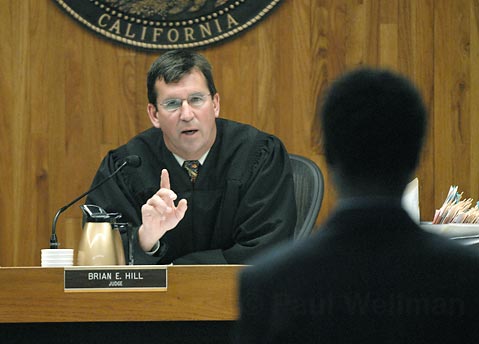Frimpong Case: Seeing Sand or Not?
Chapter Two of Joel Engel's Eric Frimpong Investigation

Read the introductory chapter in this series here.
On February 17, 2007, shortly after 1 a.m. Justin Hannah, then a UCSB senior, noticed a young woman wandering between the twin apartment buildings at 6613-6619 Del Playa, on the cliff side of the street, about 65 yards west of the small park at the foot of Camino Pescadero, where stairs at the southeast corner lead down to the beach. Walking barefoot and wearing jeans, a red T-shirt, and a leather-like jacket with a furry hood, she was crying and appeared intoxicated.
We’ll call her Jane Doe.
Hannah approached and asked if she was all right. Doe turned around and walked back the way she’d come. Hannah followed and asked, “Do you need anything?” At last Doe asked to use his cell phone, and made several calls to friends and then family. Hannah overhead her say that she thought she “might” have been raped, and it was he who talked to the second young woman she called, giving her directions to their location. He insisted on staying beside Doe even when she told him she didn’t need him anymore, and he was there at about 1:35 a.m. when an older Toyota Camry pulled up carrying two college-aged women. The door opened, Doe jumped in, the car sped away.
Some 18 hours later, Hannah received a call from Santa Barbara Sheriff’s Deputy Joel Rivlin. Hannah described the above story, noting that Doe appeared “hysterical” and “intoxicated.” He said, “She didn’t know where she was.”
Rivlin taped the phone call. It ended with Hannah saying “Bye” after Rivlin had said, “Okay, bye,” meaning that no further communication occurred. But when Rivlin wrote his report of the conversation, he added that Hannah had observed Doe “covered in sand.” Hannah, as he swore in an affidavit earlier this year, had said no such thing.
Though the audio recording and its transcription would seem to take precedence over the deputy’s notes, this fiction of the sand would continue throughout the trial and play a major supporting role in the prosecution’s case – and therefore Eric’s conviction. Without significant sand on her, how could Deputy District Attorney Barron argue at trial that Jane Doe had been raped on the beach minutes before? Anyone who’s ever visited the beach knows that sand inevitably and insidiously finds its way into shoes, toes, clothes, hair. The amount of sand in and on a naked (below the waist) victim who’s been viciously attacked on the beach would be considerable. Yet photos and video shot by medical personnel just a few hours later, before Doe had showered or changed her clothes, revealed no visible sand on her rear, legs, or feet. This absence of sand, like Hannah’s recorded statement, would be inconvenient for the prosecution.
Indeed, on April 13, 2007 – two days after interviewing Jane Doe for the first time – Barron and her chief investigator, Paul Kimes, called Hannah into her offices. Barron asked if Hannah had noticed any sand on Doe. When he said no, Barron responded, “‘Cause I think – I listened to your interview [with Rivlin] and you indicated she was covered in sand.”
Hannah insisted that he hadn’t seen any sand, nor had he described it to Rivlin. “Maybe one of her friends may have noticed it,” he said, “but I actually never noticed if she had any sand on her.”
The conversation continued. After Hannah clarified that when he encountered Doe she was walking from between the twin apartment buildings toward the parking lot adjacent to Del Playa, Barron pulled out Rivlin’s report and read aloud that he’d “stated that she was covered in sand.”
Surprised, Hannah apologized. “If that’s what I said then that’s gottta be right,” he said.
Barron replied, “[T]hat’s normal for that to happen, especially as time goes by.”
Oddly enough, Sanger never referred directly to Hannah’s recorded interview with Rivlin, which would have settled the issue of the sand. Throughout the trial, beginning with his opening remarks to the jury, Sanger essentially stipulated to the rape on the beach and the imaginary geography that made her story possible.
Read the next chapter in this series here.



